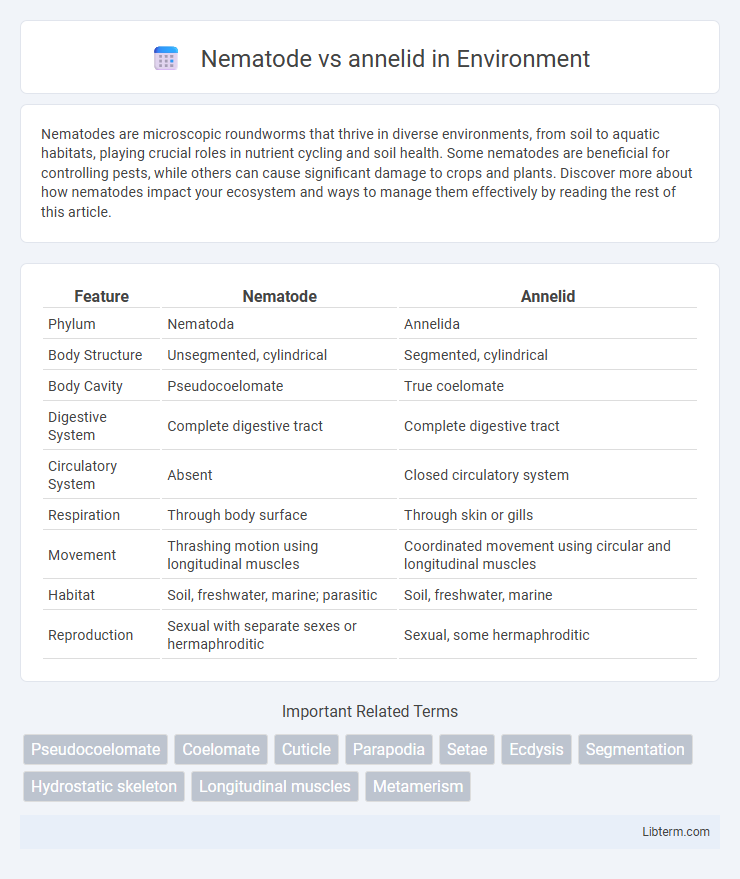Nematodes are microscopic roundworms that thrive in diverse environments, from soil to aquatic habitats, playing crucial roles in nutrient cycling and soil health. Some nematodes are beneficial for controlling pests, while others can cause significant damage to crops and plants. Discover more about how nematodes impact your ecosystem and ways to manage them effectively by reading the rest of this article.
Table of Comparison
| Feature | Nematode | Annelid |
|---|---|---|
| Phylum | Nematoda | Annelida |
| Body Structure | Unsegmented, cylindrical | Segmented, cylindrical |
| Body Cavity | Pseudocoelomate | True coelomate |
| Digestive System | Complete digestive tract | Complete digestive tract |
| Circulatory System | Absent | Closed circulatory system |
| Respiration | Through body surface | Through skin or gills |
| Movement | Thrashing motion using longitudinal muscles | Coordinated movement using circular and longitudinal muscles |
| Habitat | Soil, freshwater, marine; parasitic | Soil, freshwater, marine |
| Reproduction | Sexual with separate sexes or hermaphroditic | Sexual, some hermaphroditic |
Introduction to Nematodes and Annelids
Nematodes, also known as roundworms, are unsegmented, cylindrical worms characterized by their smooth, elongated bodies and a complete digestive system, whereas annelids are segmented worms with a body divided into repeated segments called metameres. Nematodes possess a pseudocoelom, serving as a hydrostatic skeleton, while annelids have a true coelom that supports more complex organ development and locomotion. Both phyla exhibit bilateral symmetry and play crucial roles in ecosystems, with nematodes often acting as parasites and annelids contributing to soil aeration and nutrient cycling.
Taxonomy and Classification
Nematodes belong to the phylum Nematoda, characterized by their unsegmented, cylindrical bodies and belonging to the Ecdysozoa clade, distinct from Annelids, which are segmented worms in the phylum Annelida within the Lophotrochozoa clade. Nematodes exhibit a pseudocoelomate body plan, while Annelids possess a true coelom, reflecting significant differences in their evolutionary lineage and physiological organization. Taxonomically, nematodes include diverse species such as Caenorhabditis elegans, widely studied in genetics, whereas Annelids encompass earthworms and leeches classified under classes Oligochaeta and Hirudinea, respectively.
Morphological Differences
Nematodes exhibit a cylindrical, unsegmented body covered by a tough cuticle, whereas annelids possess a segmented, soft body with distinct metameres and setae on each segment. Nematodes have a pseudocoelom and a simple tubular digestive system, while annelids feature a true coelom and a more complex, segmented digestive tract. The presence of circular and longitudinal muscles in annelids contrasts with the primarily longitudinal muscles found in nematodes, influencing their distinct locomotion styles.
Body Structure and Segmentation
Nematodes possess a cylindrical, unsegmented body with a tough cuticle, whereas annelids feature a segmented, cylindrical body divided into repeated units called metameres. The segmentation in annelids enables specialized organ systems per segment, promoting efficient movement and flexibility, while nematodes lack true segmentation, resulting in a simpler body plan with longitudinal muscles only. Annelids also have a coelom segmented by septa, contrasting with the pseudocoelom found in nematodes.
Locomotion and Movement Patterns
Nematodes exhibit thrashing movements due to their longitudinal muscles, enabling a whip-like motion through soil or water. Annelids, possessing both circular and longitudinal muscles along with a segmented body plan, utilize peristaltic contractions to achieve smooth and coordinated crawling or swimming. The hydrostatic skeleton in annelids allows greater control and versatility in locomotion compared to the more rigid, non-segmented nematodes.
Reproductive Strategies
Nematodes exhibit a wide range of reproductive strategies, primarily sexual reproduction with distinct males and females, though some species are hermaphroditic or reproduce through parthenogenesis. Annelids typically reproduce sexually as well, with separate sexes or hermaphroditism, featuring complex reproductive systems and often external or internal fertilization depending on the species. Both groups use diverse methods to ensure offspring survival, such as egg-laying in protective environments or direct development, highlighting their evolutionary adaptation to various habitats.
Habitat and Ecological Roles
Nematodes inhabit diverse environments including soil, freshwater, marine ecosystems, and as parasites within plants and animals, playing crucial roles in nutrient cycling and soil health by decomposing organic matter. Annelids primarily occupy moist terrestrial habitats and aquatic environments, such as freshwater and marine sediments, contributing significantly to soil aeration and sediment mixing through their burrowing activities. Both groups influence ecosystem dynamics, with nematodes impacting microbial populations and annelids facilitating nutrient redistribution and supporting food webs.
Feeding Habits and Digestive Systems
Nematodes possess a simple, tubular digestive system with a mouth, pharynx, intestine, and anus, enabling them to feed mainly on bacteria, fungi, and decaying organic matter. Annelids have a more complex digestive tract including a segmented gut with specialized regions like the crop and gizzard, allowing them to consume diverse diets such as soil, detritus, and small invertebrates. The varied feeding mechanisms in annelids support advanced nutrient absorption compared to the generally simpler processing in nematodes.
Medical and Agricultural Importance
Nematodes, including parasitic species like *Ascaris lumbricoides* and *Caenorhabditis elegans*, are significant in medicine due to their role in causing diseases such as ascariasis and filariasis, impacting millions globally. In agriculture, plant-parasitic nematodes like root-knot nematodes (*Meloidogyne* spp.) cause substantial crop losses by damaging roots and reducing nutrient uptake. Annelids, particularly earthworms, contribute to soil health by enhancing aeration and nutrient cycling, indirectly supporting agricultural productivity, while some marine polychaetes have limited direct medical or agricultural relevance.
Key Distinguishing Features
Nematodes possess a pseudocoelom and a non-segmented, cylindrical body covered by a tough cuticle, whereas annelids feature a true coelom and segmented, soft body with setae for locomotion. Nematodes exhibit a simple digestive system with a straight tube, while annelids have a more complex digestive tract with specialized regions. Nervous and circulatory systems are less developed in nematodes compared to the closed circulatory system and ventral nerve cord found in annelids.
Nematode Infographic

 libterm.com
libterm.com